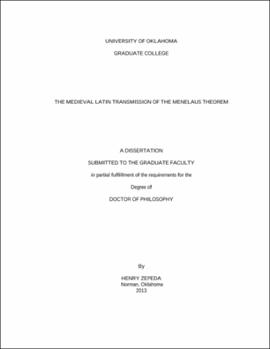| dc.description.abstract | The Menelaus Theorem, which involves the ratios between the chords of arcs arranged in a certain manner on the surface of a sphere, was the fundamental proof for spherical astronomy in antiquity and the middle ages. In this dissertation, I trace the history of this theorem throughout the middle ages. Medieval scholars did not merely copy their ancient and Islamic sources, but instead they modified and added proofs and applications. Two important trends can be seen in medieval works on the Menelaus Theorem, most of which have received little or no scholarly attention. One involves systematization. Medieval scholars molded the astronomical content of their sources into the mold of Euclid's Elements, which was a model of a deductive mathematical science. Instead of arranging the work into chapters and using examples as Ptolemy did, medieval astronomers arranged the work into structured proofs and used general proofs that avoided specific values. Astronomy retained a connection to the practice of astronomy by including general rules for calculating values. The other trend seen in the works containing the Menelaus Theorem involves quantification. The theorem uses compound ratios, which were understood by medieval mathematicians in two ways. One view saw compounding as being analogous to addition, while the other saw it as the multiplication of the numbers or fractions that correspond to ratios. While the second way was more prevalent in the medieval texts containing the Menelaus Theorem, both concepts are found in them--often mixed confusedly--and both involve seeing ratios, which were normally understood as relationships between quantities, as if they were quantities. These texts are part of a larger medieval trend of quantification of non-quantities. Editions of several works are included as appendices. | |
